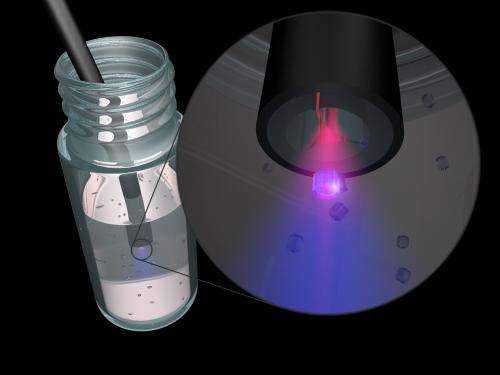Breakthrough in sensing at the nanoscale

Researchers have made a breakthrough discovery in identifying the world's most sensitive nanoparticle and measuring it from a distance using light. These super-bright, photostable and background-free nanocrystals enable a new approach to highly advanced sensing technologies using optical fibres.
This discovery, by a team of researchers from Macquarie University, the University of Adelaide, and Peking University, opens the way for rapid localisation and measurement of cells within a living environment at the nanoscale, such as the changes to a single living cell in the human body in response to chemical signals.
Published in Nature Nanotechnology today, the research outlines a new approach to advanced sensing that has been facilitated by bringing together a specific form of nanocrystal, or "SuperDot" with a special kind of optical fibre that enables light to interact with tiny (nanoscale) volumes of liquid.
"Up until now, measuring a single nanoparticle would have required placing it inside a very bulky and expensive microscope," says Professor Tanya Monro, Director of the University of Adelaide's Institute for Photonics and Advanced Sensing (IPAS) and ARC Australian Laureate Fellow. "For the first time, we've been able to detect a single nanoparticle at one end of an optical fibre from the other end. That opens up all sorts of possibilities in sensing."
"Using optical fibres we can get to many places such as inside the living human brain, next to a developing embryo, or within an artery ? locations that are inaccessible to conventional measurement tools.
"This advance ultimately paves the way to breakthroughs in medical treatment. For example, measuring a cell's reaction in real time to a cancer drug means doctors could tell at the time treatment is being delivered whether or not a person is responding to the therapy."
.jpg)
The performance of sensing at single molecular level had previously been limited by both insufficient signal strength and interference from background noise. The special optical fibre engineered at IPAS also proved useful in understanding the properties of nanoparticles. "Material scientists have faced a huge challenge in increasing the brightness of nanocrystals," says Dr. Jin, ARC Fellow at Macquarie University's Advanced Cytometry Laboratories. "Using these optical fibres, however, we have been given unprecedented insight into the light emissions. Now, thousands of emitters can be incorporated into a single SuperDot – creating a far brighter, and more easily detectable nanocrystal."
Under infrared illumination, these SuperDots selectively produce bright blue, red and infrared light, with a staggering thousand times more sensitivity than existing materials. "Neither the glass of the optical fibre nor other background biological molecules respond to infrared, so that removed the background signal issue. By exciting these SuperDots we were able to lower the detection limit to the ultimate level – a single nanoparticle," says Jin.
"The trans-disciplinary research from multiple institutions has paved the way for this innovative discovery," says Jin, "with the interface of experts in nanomaterials, photonics engineering, and biomolecular frontiers."
"These joint efforts will ultimately benefit patients around the world - for example, our industry partners Minomic International Ltd and Patrys Ltd are developing uses for SuperDots™ in cancer diagnostic kits, detecting incredibly low numbers of biomarkers within conditions like prostate and multiple myeloma cancer." Macquarie is now actively seeking other industrial partners with the capacity to jointly develop solutions outside of these fields.
Journal information: Nature Nanotechnology
Provided by University of Adelaide




















